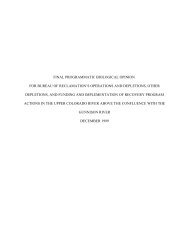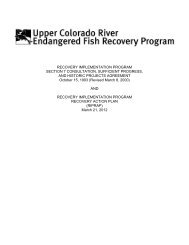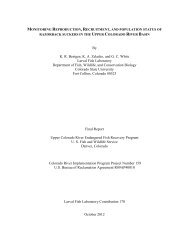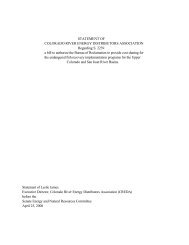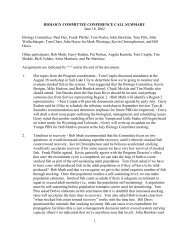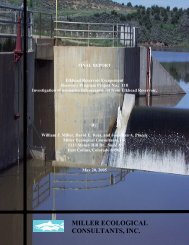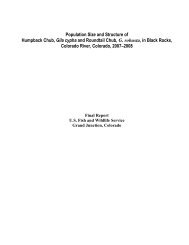Native fish monitor - Upper Colorado River Endangered Fish ...
Native fish monitor - Upper Colorado River Endangered Fish ...
Native fish monitor - Upper Colorado River Endangered Fish ...
Create successful ePaper yourself
Turn your PDF publications into a flip-book with our unique Google optimized e-Paper software.
III.A. Reduce negative impacts to endangered <strong>fish</strong>es from sport<strong>fish</strong><br />
management activities.<br />
III.A.4. Develop and implement control programs for nonnative <strong>fish</strong>es in<br />
river reaches occupied by the endangered <strong>fish</strong>es to identify<br />
Required levels of control. Each control activity will be evaluated<br />
for effectiveness, and then continued as needed.<br />
III.b.3. (Nonnative <strong>fish</strong> removal in Yampa Canyon).<br />
VI.<br />
FY09 Accomplishments, Tasks and Deliverables, Initial<br />
Findings, Shortcomings and Discussion:<br />
Task 1.<br />
Duchesne <strong>River</strong> – High Flow – Non <strong>Native</strong> <strong>Fish</strong> Monitoring<br />
Study Design<br />
The Duchesne <strong>River</strong> non native <strong>monitor</strong>ing pass consist of 42 RM, from Myton<br />
Bridge to the confluence with the Green <strong>River</strong>. For data analysis, the stream<br />
segment was divided into 2 reaches, each possessing distinct and varying habitat<br />
types, i.e., riffles, runs, pools, backwaters. Reach 1 consist of 25 RM, from<br />
Myton, Utah to Randlett, Utah; while Reach 2 consist of 17 RM, from Randlett,<br />
Utah to the confluence with the Green <strong>River</strong>. The Duchesne <strong>River</strong> non native<br />
<strong>monitor</strong>ing pass was performed on at various times during June 2009 as a<br />
cooperative effort between the Ute Indian Tribe <strong>Fish</strong> and Wildlife Department<br />
(UIT F&WD) and the US <strong>Fish</strong> and Wildlife Service (FWS) and the Utah Division<br />
of Wildlife Resources (UDWR). The species of study were smallmouth bass and<br />
any non native <strong>fish</strong> species that occupy the Duchesne <strong>River</strong>. Additionally, for the<br />
purpose of data analysis, <strong>fish</strong> surveyed were determined to be within two distinct<br />
groups, either juvenile (



